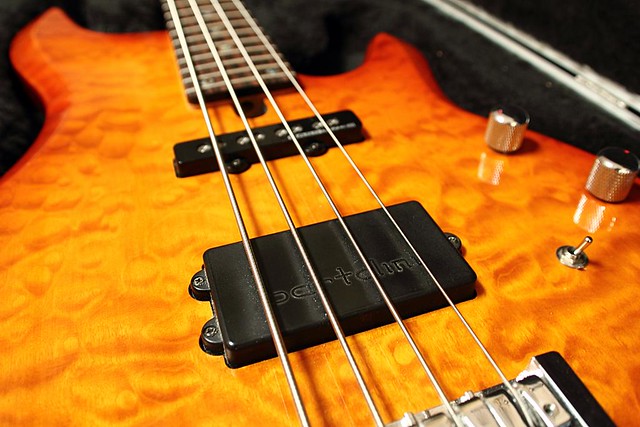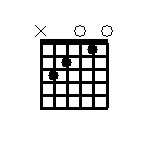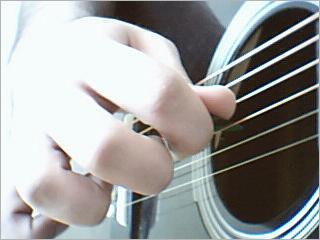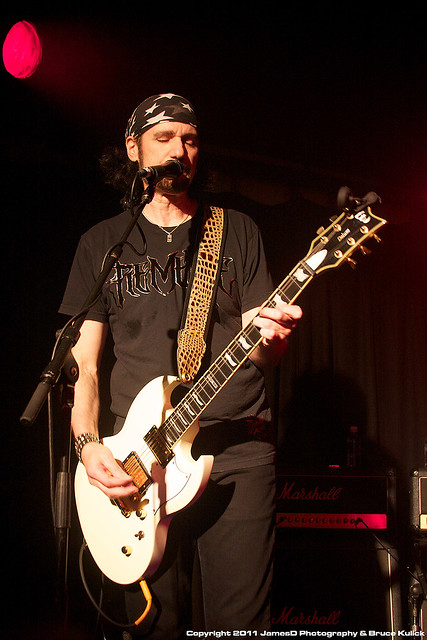It was a dark and rainy night. The courthouse clock struck midnight; a stray dog howled. It was all too beautiful when the staff of Gear Vault convened for their semi-annual secret meeting with the confines of the beloved cinder-block chamber they call their "office." Their agenda? To decide the 20 most important people on guitar.
 |
| (Photo credit: Wikipedia) |
Widely recognized as one of the most creative and influential musicians of the 20th century, Jimi Hendrix pioneered the explosive possibilities of the electric guitar. Hendrix's innovative style of combining fuzz, feedback and controlled distortion created a new musical form. Because he was unable to read or write music, it is nothing short of remarkable that Jimi Hendrix's meteoric rise in the music took place in just four short years. His musical language continues to influence a host of modern musicians, from George Clinton to Miles Davis, and Steve Vai to Jonny Lang. Hendrix was the revolutionary guitar god, enuff said!
2. Edward Van Halen
Edward Van Halen once likened his guitar playing to "falling down the stairs and landing on my feet." Eddie's had thirteen albums' worth of such happy accidents and in the process has changed the way people play, hear and think about the electric guitar. With his unorthodox technique, dare-devil whammy bar antics and fearless experimentation, Van Halen revitalized heavy guitar after it had run its course in the Seventies. Espousing an I-just-play-that's-all-I-do attitude and favoring basic gear like stock Marshalls. Peavey 5150s, homemade, slapped together guitars and simple, minimal stop box effects, Van Halen became guitar's greatest hero by becoming its unassuming anti-hero.
From the jaw-dropping gymnastics of Van Halen's "Eruption" to the eerie, tidal crescendos of "Cathedral" on Diver Down, through his 1984 chart-topping synth experiments and spirit of 5150 and For Unlawful Carnal Knowledge, Eddie has remained innovative throughout his career. Never one to wait around for the electrician, Van Halen prefers building his own gear-and if it doesn't always look pretty, well, beauty is in the ear of the beholder. By "Frankensteining" his first striped guitar from $130 worth of parts, Van Halen launched his quest for the elusive "brown sound-"big, warm and majestic"-and gave rock guitarists a new holy grail of tone to seek in the post-Jim-my page era. His single-pickup and volume control innovation changed the way guitars looked and sounded, popularized the previously obscure Kramer Guitars, and inspired the do-it-yourself guitar gear industry. Eddie's custom-designed Peavey amps and his with Sterling Ball on his Music Man guitars prove that Van Halen still believes the artist should retain creative input on his equipment.
As a player, Van Halen single-handedly-well, dual-handedly-introduced millions of rock players such exciting techniques as two-handed tapping and harmonics. Before 1978, the guitar just had to be loud and fast. Eddie's playing is also tasteful and always in context, a fact that distinguishes him from his legions of imitators. While he's unimpressed by the copycat syndrome, it cannot be denied that many players first picked up a guitar after Van Halen's dazzling licks. But none of them can fall down the stairs with such brilliance.
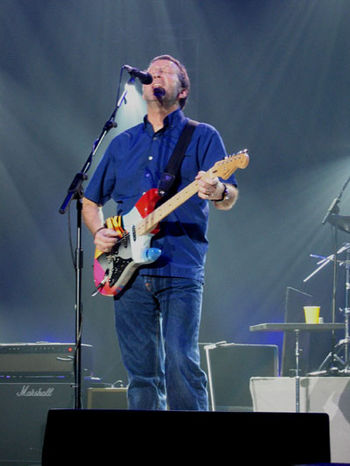 |
| (Photo credit: Wikipedia) |
Eric Clapton has successfully reinvented himself dozens of times: Rave-Up King with the Yardbirds; Holy Father of the Anglo-blues with the Bluesbreakers; a free-form improvisational genius with Cream; chameleon rises to every musical occasion.
By 1965 the 20-year-old Clapton was already a legend. He'd introduced the blues to the masses, interpreting and updating what had been a largely unknown form for the rock generation. Simultaneously, his lush, Les Paul-driven tone marked the absolute turning point in the history of rock, transforming what had been a good-time twang instrument into a vehicle for profound expression.
Ultimately, the most enduring image of the great guitarist will be of Clapton the bluesman, standing on a corner of a stage and exposing his psychic wounds to the masses. It is interesting, though, that, while "bluesy" in feel, his most memorable songs-"Layla," "Tears In Heaven"-do not utilize the blues structure.
While most of Clapton's contemporaries talk reunion and revival, he never retreats behind memories of his "good old days." His Unplugged album, which was enormously successful-both for him and acoustic guitar manufactures-included a radical remake of "Layla." Clapton is one artist who has learned how to grow up.
 |
| (Photo credit: Wikipedia) |
Paul McCartney has spent very little of his career playing six-string guitar. But as a bassist, he almost single-handedly made guitar players' jobs a whole lot easier.
When the Beatles first arrived on the scene, rarely was the bass even heard on most pop records; players seldom attempted anything more adventurous than a root-fifth accompaniment. But McCartney, who not only played bass, but sang, enlivened the Beatles' material with dynamic, moving basslines on his famous Hofner and, later, a Rickenbacker 4001. By the time the Beatles began work on Sergeant Pepper's, McCartney as pumping out bass melodies that carried entire songs, with the result that the Beatles' guitar parts often became sparser, more subtle. Within months-and, to this day-bass players, the world over was unshackled.
5. Pete Townshend
Before Pete Townshend came along, feedback was something guitarists shunned like halitosis. Pete turned it into one of rock guitar's most powerful sonic resources.
Soon after The Who debuted in 1964, Townshend became legendary for violently slamming his guitar into his Marshall stack (a form of amplification he was the first to use) and smashing his instrument to splinters at the end of each show. All of this had a profound influence on Jimi Hendrix (aka The Guitar God #1) and just about every other rocker who ever picked up a guitar. Pete's trademark "windmill" strum was actually swiped from Keith Richards. But Townshend made it even bigger and more dramatic-which is what he and The Who did with just about everything they touched. Having mastered the art of the three-minute pop song, Townshend turned his attention to 15-minute mini-operas and, with Tommy in 1969, the worlds first double album rock opera. Townshend's songwriting genius and theatrical flair tend to obscure the fact that he is also a fine guitarist, as capable of supple lyricism as he is of angry mayhem.
6. George Harrison
When George Harrison strummed his first chord during the Beatles' historic appearance on the Ed Sullivan show 44 years ago, he became the catalyst for the electric guitar's metamorphosis from stringed instruments to a tool of teenage liberation. And, as the folks at Gretsch and Rickenbacker will readily attest, it didn't exactly hurt sales, either.
While Harrison has never been a virtuoso guitarist, he was an innovator-constantly pushing the limits of studio sounds and stylistic boundaries. In many ways, he also was the first modern session musician, his chops as diverse and far-reaching as Lennon and McCartney's songwriting. He could dish up brilliant Scotty Moore-style rockabilly ("All My Loving"), heart-rendering gut-string lines ("And I lover") and sheer fuzz and fury ("Revolution")-always adding something memorable to the material. Later in his career, he developed an original slide style that is more melodic than bluesy. Like the Beatles as a whole, Harrison never settled into a comfortable groove. He glided across the musical spectrum-from country and western to spaced-out psychedelia to smooth and sweet slide-shattering conventions and then moving on.
7. Angus Young
Two decades after Angus Young first emerged AC/DC's ax-wielding dervish at age 14, we Scottish Aussie remains one of the sturdiest bridges between young metal-ists and rock's blues roots. Although he did great work before and since Young will always be best known for 1980's Back In Black, a blue-collar masterpiece which, with killer classics like "You Shook Me All Night Long," remains an all-purpose primer for riff writing and tight, scalar lead playing. Never mind the fact that the man does it all while spinning around like chinchilla on speed. Though he may be dwarfed by his signature oxblood SG, Angus Young is a giant among men.
8. Jimmy Page
Arguably the most emulated guitarist in rock history, Jimmy Page has additionally assured a place in the music's pantheon of greats for his roles as a musical director, produce and all-around guru of Led Zeppelin.
His Rampaging, blues-based work on anthems like "Whole Lotta Love," "Communication Breakdown" and "Rock And Roll" defines heavy metal. His real genius, however, was his ability to expand the parameters of the genre to include elements of traditional English folk, reggae, funk, rockabilly, and Arabic classical music.
Page the guitarist has never been facile as Edward Van Halen or Steve Via, but few players in rock history have been able to match his restless imagination or visionary approach to guitar orchestration. Whether he was exploring the exotic joys of open tuning on tracks like "Kashmir" and "Black Mountain Side," pioneering the use if backwards echo on "You Shook Me," or coaxing otherworldly sounds from his '58 Les Paul with a cello bow on "Dazed And Confused," Page consistently transcended the limitations of his instrument and the recording studio.
More than 30 years have passed since Page recorded the seminal Led Zepplin IV, but the album's gigantic imprint can still be detected in the work of such cutting-edge bands as Jane's Addiction, Stone Temple Pilots, and Soundgarden, to name a few. Page, of course, remains active. His dense, multi-layered work on the Coverdale/Page record demonstrated his refusal to rest his laurels.
9. Kurt Cobain
Kurt Cobain was the intense and unkempt grunge lord who brought Nirvana from obscurity to the top of the charts, was all the rage-literally. The king of the guitar anti-hero, he didn't play his Fender Jaguars but he mauled them in a chord-crunching fury. Inevitably, he smashed his guitars, littered stages around the world with his splintered victims.
Cobain was a guitar pioneer because he managed to fuse into one dynamic style the aggression of Seventies punk rock, the speed, and simplicity of Eighties hardcore and the bottom-heavy crunch of Nineties metal-and done so without a trace of silliness or bombast to which all three genres are prone.
There's little doubt that scores of new players have been inspired to plug in by the chugging chords of Cobain's "Smells Like Teen Spirit." Segovia, he wasn't. But Segovia never captured the angst of an entire generation with one burst of ungodly feedback.
10. David Gilmour
What makes David Gilmour truly remarkable is his uncanny ability to marry two seemingly contradictory genres-progressive rock and blues. Perhaps the most dramatic example of this unusual union can be heard on one of Pink Floyd's biggest hits, "Money" (Dark Side Of The Moon). As the song begins, Gilmour slowly builds a delicate network of spacious, effected guitars, only to topple them with a series of emotionally charged, vibrato-drenched solos, whose rich, shimmering tone and impeccable phrasing recall B.B. King, rather than King Crimson.
Gilmour is the rarest of rockers. Like Jimi Hendrix, he has the natural ability to balance the cerebral with the emotional, the technical with instinctual, while keeping an eye on both the past and the future. It is this awesome juggling act that is the secret to Pink Floyd's lasting appeal.
11. Keith Richards
Keith Richards is the archetypal rock outlaw, the quintessential skinny English rock guitarist in a tight black suit. He's filled that role since the Rolling Stones first established themselves as the dark, dangerous alternative to the Beatles in 1963. With his deep love of the blues, Keef initiated a generation of white, middle-class kids into the wonders of Muddy Waters, howling' Wolf and Chuck Berry. His unique five-string, open-G tuning lies at the heart of such all-time power chord classics as "Jumpin' Jack Flash" and "Street Fighting Man." As a soloist, Keef has worked a few miracles; witness the icy, amphetamine mesmerism of his licks on "Sympathy For The Devil" and his buoyant bending on "Happy." And he is the author of the most-played riff in all rock: the tritone mating call of "Satisfaction." Much has been made of Richards' fondness for controlled substances, but his ultimate drug is music; his knowledge of rock, blues and reggae is encyclopedic, his passion for them boundless. They have sustained him through imprisonment, addiction, tempestuous lines of his leathery face, the history of rock and roll is etched.
12. Eric Johnson
In a realm often dominated by ham-fisted machismo, Eric Johnson stands apart as rock guitar's elegant poet laureate. He has managed to create an original style from such radically dissimilar sources as country chicken picking, Jimi Hendrix, and jazzman Wes Montgomery. A legend long before he became famous, Johnson's seemingly endless, melodious lines and distinctive "violin" tone made it an absolute requirement for guitarists stopping near the Texan's hometown of Austin to attend his show there in the early/mid-1980s.
After turning down numerous offers to tour as a sideman, he rose to prominence in 1986 with his critically acclaimed, Grammy-nominated album, Tones. His follow-up, Ah Via Musicom, thrust the self-effacing innovator further into the spotlight, yielding one Grammy-winning cut ("Cliffs Of Dover") and eventually going gold. Combining passion and lyricism with what can only be described as an overwhelmingly positive vibe, Johnson's music is progressive without being academic, uplifting without stooping to sentimentality.
13. Buddy Guy
"Part of my reason for forming Cream have I suddenly had this mad idea about being English Buddy Guy; my goal was to be Buddy Guy with a composing bass player... And to this day, when he's on I don't think anyone can touch him. He takes you away to somewhere completely different." -Eric Clapton
"Buddy Guy is as close as you can come to the hear of the blues." -Jeff Beck
"He plays one note and you forget about the rent." -Carlos Santana
"Nobody can get out of tune as cool as Buddy Guy." Stevie Ray Vaughan
14. Yngwie Malmsteen
Two schools of thought have sprung over the years regarding Yngwie J. Malmsteen. On the one hand, the Swedish native's incredibly precise, rapid-fire playing has earned him as a profound and brilliant artist, the founder and most important exponent of the neo-classical guitar. From the point of view of this school, the effortless blend of raw speed, finesse, and passion that has characterized Malmsteen's style since his 1984 solo debut, Rising Force, represents the pinnacle of fretboard achievement. Yngwie is also credited with popularizing the scalloped guitar neck.
But Yngwie is also scorned by many in the guitar community, who loathe him with an intensity that matches the ardor of his most dedicated boosters. To the group, Malmsteen was the architect of cold, empty guitar style, which emphasized technique over art, speed over feel. They rejoice over the apparent demise of neo-classicism. And how do you plead-for Yngwie or against?
15. Dimebag Darrell
This authentic, crimson-bearded lone star madman had rewritten the book on heavy metal riffing in the short space by many major-label releases. By combining the virtuosity of Edward Van Halen with the rhythmic drive of a glue-sniffing punk rocker, the legend Pantera guitarist had created a highly individual sound that that appeals to classic rockers, fans of death metal and industrial headbangers. On Pantera's March 15, 1994, release, Far Beyond Driven, Darrell solidified his reputation as one of metal's true originals on tracks like "Good Friends And A Bottle Of Pills," which combines hell-and-damnation riffing with the kind of abrasive avant-garde noodling that put Sonic Youth on the map.
16. John Petrucci
Known as Dream Theater, John Petrucci is proud to be progressive. "Our style is completely different from grunge and alternative music," says the 41-year-old Berklee-trained musician. "But I think our music has as much attitude as any of those bands."
Dream Theater is known for a complicated, textured style of hard rock that embraces flawless musicianship, lengthy improve sections, daring arrangements and other flashy elements made popular by Yes, Kansas, Rush and other old-school rockers. Leading the progressive charge is the technically masterful Petrucci, whose playing encompasses angular melodic phrases, liquid chromatics and manic displays of speed-picking into an exciting, coherent style.
Despite his reputation, the Ibanez-wielding shredder remains modest; "Being looked at as a guitar hero is very flattering, but being singled out away from the rest of the band doesn't appeal to me," says Petrucci. "I'd prefer to have people view me as a talented musician in a good band-not as some flashy soloist." Not a chance.
17. B.B. King
As the universally hailed ambassador of the blues, B.B. King has introduced his favorite music to more people the world over than all other artists combined. In fact, he's so highly visible-popping up everywhere from ads for Northwestern Airlines and McDonald's to an episode of "Sanford And Son" and "Married With Children"-that it's easy to take for granted and forget why he became so revered in the first place.
B.B. King has an incredibly expressive, vocal vibrato and an unmistakable, ringing tone, both of which have been imitated by legions of admirers. He is also the master of the perfectly placed bent note, stretching his strings with eloquence, brilliant timing and consistently perfect intonation. But what is perhaps most impressive about B.B. King is that despite hanging over 300 nights a year for decades, and despite having attained cultural icon status long ago, he has avoided slipping into complacency. He never plays the same solo twice and to this day stretches himself, demonstrating night after night exactly why he is the King Of The Blues.
18. Joe Satriani and Steve Vai -- Both rockers are equal careers and talent.
Starting with Joe Satriani, a walking warehouse of virtually every rock guitar style and technique ever developed. From delicate, classical-style finger-picking to the most profane vibrato-bar molestation, Joe knows it all. He elevates the level of whatever he's playing with his passion for sonic adventure and dead-eye sense of song and orchestration.
Like a human melting pot, Satriani has managed to integrate such disparate influences as surf guitar, world beat, and Jimi Hendrix into his playing. His much-lauded 1987 breakthrough album, Surfing With The Alien, almost single-handedly rehabilitated instrumental rock as a mainstream genre and help bury the myth that a thoughtful, educated player couldn't rock. In the manner of the Blow By Blow-era Jeff Beck. Satriani employs his superior technique and seemingly inexhaustible vocabulary of licks, riffs, and styles in the service of memorable songs (rather than the other way around). And he continues to do this exhibitionism, traps that have foiled too many of his peers.
Steve Vai's unparalleled technique and effortless flash made him rock's paramount pair of hired hands in the 1980's. He rendered PIL more accessible, empowered David Lee Roth, gave Whitesnake artistic credibility and even shredded for the Devil in a sensational performance in the film Crossroads.
But it was with 1990's Passion And Warfare-perhaps the most anticipated guitar release of all time-that Vai crystallized his technical skills, incredible drive, and explosive vision into a sensitive, acutely personal guitar statement. He shifts gears with the greatest of ease, gliding from delicate lyricism to the back. Like a demented circus master, Vai has the power to amuse and frighten with his most dangerous menagerie of sound.
19. Joe Perry
For 35 years, though not one or two, but several climbs to the top, Aerosmith's Joe Perry has been a living testimony to the power of a Bad-Ass Attitude. Perry's perpetual sneer is expressed not merely on his chiseled face, but also through his guitars and overdriven amps. Of course, he's also written some pretty decent riffs, the best of which completely defines their song; it's impossible for even non-guitarists to think of "Walk This Way" or "Sweet Emotion" without humming Perry's etched-in-stone guitar lines.
20. Zakk Wylde
Zakk Wylde's hellacious guitar playing and charismatic stage presence made him a keeper of the heavy metal flame with Ozzy Osbourne for many years. But you ain't heard nothin' yet. Zakk started a few bands of his own, Pride & Glory and his most recent, Black Label Society (BLS), frenzied, high octane slab of guitar mayhem. It's a molten mix of Zakk's two selves: his heavy, energetic Ozzyfield side and the hell-bent Southern rocker and ruthless side. Step out of the way and make peace with yo' maker, son.
By Chaz Beers
Chaz is a passionate music lover and guitar player. He's been playing guitar for over 25 years. Chaz is also the owner of one of the most respectable guitar review websites on the entire internet. Read his professional and comprehensive guitar and amplifiers reviews before you buy your next guitar or piece of musical equipment. If you are a Dimebag fan like I am, then check out a history of the Dimebag Dean ML Guitar.
Article Source: EzineArticles
|




